Chorizo
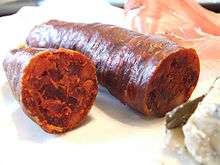 Spanish chorizo | |
| Course | Sausage |
|---|---|
| Place of origin | Spain, Portugal |
| Main ingredients | pork, paprika |
|
| |
Chorizo (Spanish) or chouriço (Portuguese) is a type of pork sausage. Traditionally, it uses natural casings made from intestines, a method used since Roman times.
Chorizo may be cooked before eating. In Europe, it is more frequently a fermented, cured, smoked sausage, in which case it is often sliced and eaten without cooking, and can be added as an ingredient to add flavor to other dishes. Spanish chorizo and Portuguese chouriço get their distinctive smokiness and deep red color from dried smoked red peppers (pimentón/pimentão).[1]
Due to culinary tradition and the high cost of imported Spanish smoked paprika, Mexican chorizo is usually made with native chili peppers of the same Capsicum annuum species, used otherwise rarely in Mexican cuisine, however as used extensively in Mexican-American restaurants. Spanish-American cuisine adds vinegar instead of the white wine usually used in Spain.
Chorizo can be eaten sliced in a sandwich, grilled, fried, or simmered in liquid, including apple cider or other strong alcoholic beverage such as aguardiente. It also can be used as a partial replacement for ground (minced) beef or pork.[2]
Names
Several different names and spellings are used:
- Asturian: chorizu (pronounced: [tʃoˈɾiθu])
- Basque: txorizo ([tʃoˈɾis̻o])
- Catalan: xoriço ([ʃuˈɾisu])
- Galician: chourizo ([tʃowˈɾiθo])
- Portuguese: chouriço ([ʃoˈɾisu])
- Spanish: Chorizo ([tʃoˈɾiθo] or [tʃoˈɾiso])
The etymology of chorizo is uncertain. It was formerly thought to derive from the Latin salsicium, meaning "salted".[3] In English, chorizo is usually pronounced /tʃəˈriːzoʊ, -soʊ/.[4] Non-English pronunciations are sometimes heard, including /tʃəˈriːθoʊ/, mimicking Castilian Spanish pronunciation.
Spanish chorizo

Spanish chorizo is made from coarsely chopped pork and pork fat, seasoned with pimentón – a smoked paprika – and salt. It is generally classed as either picante (spicy) or dulce (sweet), depending upon the type of pimentón used. Hundreds of regional varieties of Spanish chorizo, both smoked and unsmoked, may contain garlic, herbs, and other ingredients.[5] For example, Chorizo de Pamplona is a thicker sausage with the meat more finely ground. Among the varieties is chorizo Riojano from the La Rioja region, which has PGI protection within the EU.
Chorizo is made in short or long and hard or soft varieties; leaner varieties are suited to being eaten at room temperature as an appetizer or tapas, whereas the fattier versions are generally used for cooking.[6] A rule of thumb is that long, thin chorizos are sweet, and short chorizos are spicy, although this is not always the case.[7]
Spain produces many other pork specialties as well, such as lomo embuchado or salchichón, cured and air-dried in a similar way. Lomo is a lean, cured meat to slice, made from the loin of the pig, which is marinated and then air-dried. Salchichón is another cured sausage without the pimentón seasoning of chorizo, but flavoured with black peppercorns instead.[8]
Depending on the variety, chorizo can be eaten sliced without further cooking, sometimes sliced in a sandwich, or grilled, fried, or baked alongside other foodstuffs, and is also an ingredient in several dishes where it accompanies beans, such as fabada or cocido madrileño.
The version of these dishes con todos los sacramentos (with all the trimmings, literally sacraments) adds to chorizo other preserved meats such as tocino (cured bacon) and morcilla (blood sausage).
Portuguese chouriço
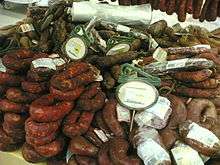

Portuguese chouriço is made (at least) with pork, fat, wine, paprika, garlic, and salt. It is then stuffed into natural or artificial casings and slowly dried over smoke. The many different varieties differ in color, shape, seasoning, and taste. Many dishes of Portuguese cuisine and Brazilian cuisine make use of chouriço – cozido à portuguesa and feijoada are just two of them.
A popular way to prepare chouriço is partially sliced and flame-cooked over alcohol at the table (chouriço à bombeiro).[9] Special glazed earthenware dishes with a lattice top are used for this purpose.
In Johannesburg, South Africa, the high influx of Portuguese immigrants in the 1960s from Portugal and Mozambique tended to settle in a suburb called La Rochelle (Little Portugal) and though most of them have either returned to Portugal or moved on to more affluent suburbs in the city, restaurants in the area as well as the very well supported annual 'Lusitoland" fundraiser festival have chouriço as the centrepiece of many items on the menus.
In the heavily Portuguese counties in Rhode Island and southeastern Massachusetts, chouriço is often served with little neck clams and white beans. Chouriço sandwiches on grinder rolls, with sautéed green peppers and onions, are commonly available at local delis and convenience stores. Stuffed quahogs (also known as stuffies), a Rhode Island specialty, usually include chouriço.
In Portugal, a blood chouriço (chouriço de sangue) similar to the black pudding is made, amongst many other types of enchidos (Spanish: embutido), such as alheira, linguiça, morcela, farinheira, chouriço de Vinho, chouriço de ossos, chourição, cacholeira, paia, paio, paiola, paiote, and tripa enfarinhada.
Mexican chorizo
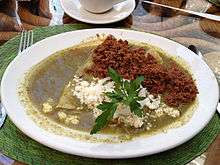
Based on the uncooked Spanish chorizo fresco (fresh chorizo), the Mexican versions of chorizo are made from fatty pork, but beef, venison, chicken, kosher, turkey, and even tofu and vegan versions are made. The meat is usually ground (minced) rather than chopped, and different seasonings are used. This type is better known in Mexico and other parts of the Americas, including the border areas of the United States, and is not frequently found in Europe. Chorizo and longaniza are not considered the same thing in Mexico.
The area of around Toluca, known as the capital of chorizo outside of the Iberian Peninsula, specializes in "green" chorizo, made with tomatillo, cilantro, chili peppers, garlic, or a combination of these. The green chorizo recipe is native to Toluca. Most Mexican chorizo is a deep reddish color, and is largely available in two varieties, fresh and dried, though fresh is much more common. Quality chorizo consists of good cuts of pork stuffed in intestinal casings,[10] while some of the cheapest commercial styles use variety meats stuffed in inedible plastic casing to resemble sausage links. Before consumption, the casing is usually cut open and the sausage is fried in a pan and mashed with a fork until it resembles finely minced ground beef. A common alternative recipe doesn't have casings. Pork and beef are cured overnightlittle vinegar and a lot of chili powder. Served for breakfast, lunch, or dinner, it has the finely minced texture mentioned above, and is quite intense in flavor.
In Mexico, restaurants and food stands make tacos, queso fundido (or choriqueso), burritos, and tortas with cooked chorizo, and it is also a popular pizza topping. Chorizo con huevos is a popular breakfast dish in Mexico and areas of Mexican immigration. It is made by mixing fried chorizo with scrambled eggs. Chorizo con huevos is often used in breakfast burritos, tacos, and taquitos. A popular Mexican recipe in which chorizo is used as an ingredient is to combine it with pinto or black refried beans. This is done by simply frying the chorizo and then combining it with refried beans. This combination is often used in tortas as a spread, or as a side dish where plain refried beans would normally be served. In Mexico, chorizo is also used to make the popular appetizer chorizo con queso (or choriqueso), which is small pieces of chorizo served in or on melted cheese, and eaten with small corn tortillas. In heavily Mexican parts of the United States, a popular filling for breakfast tacos is chorizo con papas, or diced potatoes sautéed until soft with chorizo mixed in.
Puerto Rico, Panama, and the Dominican Republic
In Puerto Rico, Panama, and the Dominican Republic, chorizo and longaniza are considered two separate meats. Puerto Rican chorizo is a smoked, well-seasoned sausage nearly identical to the smoked versions in Spain. Puerto Rican and Dominican longanizas have a very different taste and appearance. Seasoned meat is stuffed into pork casing and is formed very long by hand. It is then hung to air-dry. Longaniza can then be fried in oil or cooked with rice or beans. It is eaten with many different dishes.
Chorizo is a popular pizza topping in Puerto Rico.
South America
In Ecuador, many types of sausage have been directly adopted from European or North American cuisine. All sorts of salami, either raw or smoked, are just known as salami. Most commonly known are sorts from Spanish chorizo, Italian pepperoni, and wiener sausages; wieners are the most popular. Some local specialities include morcilla, longaniza, and chorizo. Morcilla, as in most Spanish-speaking countries, is basically cooked pork blood encased in pork intestine casing (black pudding in English). Longaniza is a thin sausage containing almost any mixture of meat, fat, or even cartilage, smoked rather than fresh. Chorizo is a mixture of chopped pork meat, pork fat, salt, whole pepper grains, cinnamon, achiote, and other spices, which produce its characteristic deep red color. A traditional dish consists of fried egg, mashed potatoes, half an avocado, salad, and slices of fried chorizo.
In Argentina, Uruguay, Bolivia, Peru, and Colombia, chorizo is the name for any coarse meat sausage. Spanish-style chorizo is also available, and is distinguished by the name "chorizo español" (Spanish chorizo). Argentine chorizos are normally made of pork, and are not spicy hot. Some Argentine chorizos include other types of meat, typically beef. In Argentina, Bolivia, Paraguay, Uruguay, Chile, and Peru, a fresh chorizo, cooked and served in a bread roll, is called a choripán. In Colombia, chorizo is usually accompanied by arepa.
In Brazil, chouriço is the word used for what in the rest of Latin America is morcilla; meat sausages similar to the chorizos of other Latin American countries are called linguiça. Many varieties of Portuguese-style chouriço and linguiça are used in many different types of dishes, such as feijoada.
In Bolivia, chorizos are made of pork, fried and served with salad (tomato, lettuce, onion, boiled carrots and quirquiña), mote, and a slice of bread soaked with chorizo fat. Chorizo sandwiches, without mote, are also eaten.
Goan chouriço

In Goa, India, chouriço has made a deep impact among the local Catholic community owing to more than 450 years of Portuguese rule. Here, chouriço is made from a mixture of pork, vinegar, red chilies, garlic, ginger, cumin, turmeric, cloves, pepper, and cinnamon - a combination which is extremely hot, spicy, and flavorful - that is stuffed into cow/ox intestine casings. These are enjoyed either with the local Goan bread (e.g. pão), or pearl onions, or both. They are also used in a rice-based dish called pulão. As a raw product they must be cooked, unlike the alternative smoked or cured varieties.

Three kinds of chouriço are found in Goa: dry, wet, and skin. Dry chouriço is aged in the sun for long periods (three months or more). Wet chouriço has been aged for about a month. Skin chouriço, also aged, is rare and difficult to find. It consists primarily of pork skin and some fat. All three chouriço are made in variations such as hot, medium, and mild. Other variations exist, depending on the size of the links, which range from 1 in (smallest) to 6 in. Typically, the wet varieties tend to be longer than the dry ones.
In Goa, tourists often refer to chouriço as "sausage", which causes it to be often confused with "Goan frankfurters". These are very different from chouriço. In looks, they are similar to sausage links as found in the United States, and they taste similar to Portuguese sausage links, known as linguiça. The meat is coarsely ground and has primarily a peppercorn flavor.
Philippines
Longaniza (Tagalog: longganisa; Visayan: chorizo, soriso) are Philippine chorizos flavored with indigenous spices, and may be made of chicken, beef, or even tuna. While the term longaniza refers to fresh sausages, it is also used in the Philippines to refer to cured sausages.
Longaniza-making has a long tradition in the Philippines, with each region having its own variety. Among others, Lucban longaniza is known for its garlicky profile, while longniza made in Guagua has a salty, almost sour flavor. Longganisang hamonado (Spanish: longaniza jamonada), by contrast, is known for its distinctive sweet taste. They are also sometimes classed into Spanish-style and Chinese-style, and are used in dishes influenced by those cuisines such as paella, and pancit.
East Timor
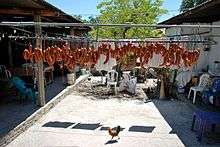
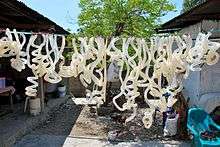
Chouriço is also made in East Timor, which is a former Portuguese colony.
Chaurice
Creole and Cajun cuisine both feature a variant of chorizo called chaurice, which is frequently used in the Creole dish of red beans and rice.
See also
 Food portal
Food portal
References
- ↑ Tara Morgan (2015-06-15). "From Choricero to Chorizo: The Rare Pepper that Makes Traditional Basque Sausage Sing | Edible Idaho". Edibleidaho.ediblefeast.com. Retrieved 2016-11-18.
- ↑ Predika, Jerry (1983). The Sausage-making Cookbook. Harrisburg, PA: Stackpole Books. p. 32. ISBN 978-0-8117-1693-2.
- ↑ "Dictionnaire Latin Français". S.A.R.L. idéMobi. Archived from the original on 13 November 2013. Retrieved 28 November 2016.
- ↑ "Chorizo | Definition of Chorizo by Merriam-Webster". Merriam-webster.com. Retrieved 2016-11-18.
- ↑ "Archived copy". Archived from the original on 15 September 2008. Retrieved 2008-09-14.
- ↑ Trutter, Marion (2010). Culinaria Spain. Hf Ullmann. p. 343. ISBN 084167227X.
- ↑ Aris, Pepita (2003). Spanish: over 150 mouthwatering step-by-step recipes. London: Hermes House. pp. 54–55. ISBN 0681304006.
- ↑ "Archived copy". Archived from the original on 12 May 2015. Retrieved 2015-08-06.
- ↑ "Chouriço à Bombeiro (Flame Grilled Chouriço)". Easyportugueserecipes.com. 2015-08-11. Retrieved 2016-10-11.
- ↑ "Chorizo Recipes for the Spice Lover in All of Us". Lets-make-sausage.com. Retrieved 2016-10-11.
External links
| Wikimedia Commons has media related to Chorizo. |
| Look up chorizo in Wiktionary, the free dictionary. |
 Chorizo at Wikibook Cookbooks
Chorizo at Wikibook Cookbooks- Portuguese sausage (linguiça) in Havai
- gmanews.tv/video, Vigan folk hold longanisa festival – 23 January 2008 (in Filipino)
- Nutrition Facts for chorizo

